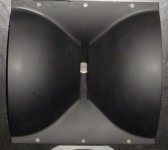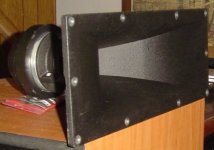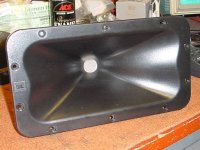Robh3606 said:Here is number 2 It's the exponential horn. A baffled 2307/H91 horn used in many of the vintage JBL systems and in the 434X large format 4 way monitors. The measurements are without 2308 lense in place.
Rob
Which, of course, is a diffraction horn in that configuration.
I fear that your conditions for these examples was misleading as I naturally assumed that they had similar conditions, like length, mouth area and treatment, EQ and particularly important, the driver. I fear that they don't even all have the same driver - is that correct? (That would totally invalidate any comparisons.)
If you want to make a true comparison of a design where people could tell real differences in the design from differences in the situation then you need to control the variables.
And I have to say at this point that I fear that all this discussion of CSD misses a very important point. It is one direction only and there a multitude of these directions. I find the CSD interesting but it is only a small part of the whole picture.
Robh3606 said:Hello Earl
I am calling the narrowing in the throat a diffraction device. I assumed that any narrowing or impingement into the horn that obscures the drivers throat qualifies. Is that correct??
Rob
This appears to be OS in the vertical, but yes there is a very clear diffraction slot in that photo.
Actually any abrupt change in wall contour qualifies. I was just yesterday having a discussion of waveguides with a guy on ProSoundWeb. He was asking similar question about what constitutes a difraction device from a waveguide. To make a long story short(er) it is a continuum with no clear point of transition. On one extreme is the old style diffraction device with a sharp edge nearly all the way arround the device. The other extreme are the waveguides based on the Seperable coordinate systems as I describe in my book. This later case can be proven to have the minimum internal diffraction for any configuration of square, round, elliptical, etc. Nothing can do better.
Anything in between is a combination of both ends. Some combinations work better than others. I choose to stick to the extreme low diffraction end because I am after the best sound quality with little or no consideration for manufacturing, market demands, etc.
What is not clear is that I can make a device that has the minimum possible diffraction for any situation. I have not done this for the market, but I can do it. Of course all of my devices are bigger than the more diffracting devices. Generally the diffraction end is much smaller than the low diffraction end. That is almost universally what drives designs to the diffraction end of the spectrum.
Hello Earl
"I fear that your conditions for these examples was misleading as I naturally assumed that they had similar conditions, like length, mouth area and treatment, EQ and particularly important, the driver. I fear that they don't even all have the same driver - is that correct? (That would totally invalidate any comparisons.)"
The one inch horns 2344, 2370 and 2307 are all with the same driver. When you are comparing various horns how can you keep them the conditions the same meaning length, mouth area and treatment the same aside from Driver/EQ?? Each CD horn will require a different electrical EQ for flat on axis response. The exponential for all intent and purposes self EQ on axis with the changing directivity.
Aside from the same driver used and EQ, which makes sense because that is the end use, how would you compare different horn patterns in the same family and different horn/waveguide types??
Thinking about it in retrospect the test baffle as another variable??
Rob
"I fear that your conditions for these examples was misleading as I naturally assumed that they had similar conditions, like length, mouth area and treatment, EQ and particularly important, the driver. I fear that they don't even all have the same driver - is that correct? (That would totally invalidate any comparisons.)"
The one inch horns 2344, 2370 and 2307 are all with the same driver. When you are comparing various horns how can you keep them the conditions the same meaning length, mouth area and treatment the same aside from Driver/EQ?? Each CD horn will require a different electrical EQ for flat on axis response. The exponential for all intent and purposes self EQ on axis with the changing directivity.
Aside from the same driver used and EQ, which makes sense because that is the end use, how would you compare different horn patterns in the same family and different horn/waveguide types??
Thinking about it in retrospect the test baffle as another variable??
Rob
Rob
It is very difficult to do these comparisons, agreed.
The two things that I think have to be held constant for comparisons are the driver and the mouth radius.
In my experience the baffle makes virtually no difference, unless the horn is terminated like that shown without the lense.
Mouth area will not have a strong effect on CSD, but has a big effect on coverage pattern. Length is virtually irrelavent in cases where there is a mouth flare.
Mouth flare is critical to the CSD. If there is not enough mouth flare then the mouth refections and standing waves will swamp the internal diffraction unless this diffraction if very high.
The EQ is always hard to judge. For instance if one uses a digital FFT EQ on a device at the same point that the CSD is done then it will be virtually perfect for any device. You won't learn a thing from such an experiment. But off axis will be all messed up with the digital flattening.
In short, it really behoves us to discuss the comparisons, what they mean and what limitations the measures have. This, of course, will never come to a consensus because everyone will have there own opinions about what matters most. People claim that I measure what shows my designs up best, but I claim that I learned what measurements are the most important and designed to those. The end result is the same, but the interpretation is completely different.
As I have said many times, to me the polar map is the most telling as this gives the "biggest" picture in the clearest light. CSD is interesting but I can beat that every time if I know that will be the criteria. But CSD alone is not the answer, it's a part of the answer and IMO not a very big part. Thats why my measurements have the noise situation that shows up in the CSD, because I don't look at CSD and so I didn't see what I wasn't looking for. I'm a little interested in CSD, enough to try and clean up my measurements to show the CSD better. Although I will use the spectrogram not CSD warterfalls - I don't like how you can't see levels clearly on the waterfalls and it makes it hard to spot things like noise.
The fact that all of these measures really aren't comparable because of so much variation in the conditions is a big reason why there is so much disagreement.
It is very difficult to do these comparisons, agreed.
The two things that I think have to be held constant for comparisons are the driver and the mouth radius.
In my experience the baffle makes virtually no difference, unless the horn is terminated like that shown without the lense.
Mouth area will not have a strong effect on CSD, but has a big effect on coverage pattern. Length is virtually irrelavent in cases where there is a mouth flare.
Mouth flare is critical to the CSD. If there is not enough mouth flare then the mouth refections and standing waves will swamp the internal diffraction unless this diffraction if very high.
The EQ is always hard to judge. For instance if one uses a digital FFT EQ on a device at the same point that the CSD is done then it will be virtually perfect for any device. You won't learn a thing from such an experiment. But off axis will be all messed up with the digital flattening.
In short, it really behoves us to discuss the comparisons, what they mean and what limitations the measures have. This, of course, will never come to a consensus because everyone will have there own opinions about what matters most. People claim that I measure what shows my designs up best, but I claim that I learned what measurements are the most important and designed to those. The end result is the same, but the interpretation is completely different.
As I have said many times, to me the polar map is the most telling as this gives the "biggest" picture in the clearest light. CSD is interesting but I can beat that every time if I know that will be the criteria. But CSD alone is not the answer, it's a part of the answer and IMO not a very big part. Thats why my measurements have the noise situation that shows up in the CSD, because I don't look at CSD and so I didn't see what I wasn't looking for. I'm a little interested in CSD, enough to try and clean up my measurements to show the CSD better. Although I will use the spectrogram not CSD warterfalls - I don't like how you can't see levels clearly on the waterfalls and it makes it hard to spot things like noise.
The fact that all of these measures really aren't comparable because of so much variation in the conditions is a big reason why there is so much disagreement.
Because of the diffraction lens, or without it, becasue of the sharp transition between the mouth and baffle?gedlee said:
Which, of course, is a diffraction horn in that configuration.
ZilchLab said:Because of the diffraction lens, or without it, becasue of the sharp transition between the mouth and baffle?
The sharp transition at the mouth. The mouth diffraction will pretty much dominate everything - the polar response, the CSD, the axial response - just as the data shows.
I've read that whole post and responded to it. I am not in complete agreement, but for the most part its valid.
Where I mostly don't agree with his approach is the use of too many crossover points. This is bound to cause trouble. Crossovers are the devil in disguise. There is nothing "good" about them. Best to use as few as possible.
He doesn't post polar plots. I do.
Where I mostly don't agree with his approach is the use of too many crossover points. This is bound to cause trouble. Crossovers are the devil in disguise. There is nothing "good" about them. Best to use as few as possible.
He doesn't post polar plots. I do.
Two-ways are a tough nut. Just when I think I'm good to 20K, they want 50K.Where I mostly don't agree with his approach is the use of too many crossover points. This is bound to cause trouble. Crossovers are the devil in disguise. There is nothing "good" about them. Best to use as few as possible. [/B]
Sonically, my priority has shifted to the low end. Mid-bass drivers do a better job getting to 1+ kHz, so I may be moving to 2.x-way. They can add a supertweeter if that flips their pages.
[Waiting for RobH to spill the rest of the beans here....
 ]
]"The fact that all of these measures really aren't comparable because of so much variation in the conditions is a big reason why there is so much disagreement."
I am not sure I understand what you are saying here. Do you mean the set of measurements in the thread or measurements in general or simply both cases.
To finish out number 3 is a 2344 Biradial photo attached and 4 is a Flat Front Biradial 2370 horn
Thanks Rob
I am not sure I understand what you are saying here. Do you mean the set of measurements in the thread or measurements in general or simply both cases.
To finish out number 3 is a 2344 Biradial photo attached and 4 is a Flat Front Biradial 2370 horn
Thanks Rob
Attachments
Robh3606 said:[BI am not sure I understand what you are saying here. Do you mean the set of measurements in the thread or measurements in general or simply both cases.
Thanks Rob[/B]
More the measurements in this thread. They all have different drivers and the drivers have resonances. So it very hard to tell what resonances are from the driver and what are from the horn. Resonances are resonances.
I might have to do a study sometime of the spectragram to see if the HOM can be seen in it. To do that I'd have to create some HOM and use a common driver and the same mouth size and flare. But making horns is not that easy.
"So none was a waveguide. Why did you say there was?"
JBL calls all of their PTH series Waveguides. That is what I am used to calling them. To me it was an improved 2344 which is what it replaced in one of my set-ups. Same size and coverage patern. Looking at the 2344 CSD and the 1010 they are very different. The 1010 looks much better to me.
Here take a look:
http://www.jblpro.com/PD5000/PDF/PT_WaveGuide.pdf
Rob
JBL calls all of their PTH series Waveguides. That is what I am used to calling them. To me it was an improved 2344 which is what it replaced in one of my set-ups. Same size and coverage patern. Looking at the 2344 CSD and the 1010 they are very different. The 1010 looks much better to me.
Here take a look:
http://www.jblpro.com/PD5000/PDF/PT_WaveGuide.pdf
Rob
SunRa said:I hope the first one is the waveguide
SCORE!!
[Well, at least "Head and shoulders better than most diffraction horns...."
Robh3606 said:"So none was a waveguide. Why did you say there was?"
JBL calls all of their PTH series Waveguides. That is what I am used to calling them. Rob
Others can bastardize the term "waveguides", but that doesn't mean that I have to. If it has intentional diffraction as a directivity controlling means then, to me, it is a difraction horn. Smooth it, round it, do whatever you want, it still relies on diffraction for its control, and that, to me, is a no-no.
I can do any of those devices without diffraction and I prefer to do that. Granted, I might have trouble with the size contraints, but for non-pro applications where sound quality is the primary objective, size should not dictate the design.
gedlee said:
Others can bastardize the term "waveguides", but that doesn't mean that I have to. If it has intentional diffraction as a directivity controlling means then, to me, it is a difraction horn. Smooth it, round it, do whatever you want, it still relies on diffraction for its control, and that, to me, is a no-no.
I can do any of those devices without diffraction and I prefer to do that. Granted, I might have trouble with the size contraints, but for non-pro applications where sound quality is the primary objective, size should not dictate the design.
Just a 15inch cone with puffy rounded mouth lips and a foam insert is roughly the good stuff? Or there is much more to correctly describe the idea in layman's terms?
gedlee said:
Others can bastardize the term "waveguides", but that doesn't mean that I have to. If it has intentional diffraction as a directivity controlling means then, to me, it is a difraction horn. Smooth it, round it, do whatever you want, it still relies on diffraction for its control, and that, to me, is a no-no.
"Diffraction waveguide" is an oxymoron in your view, then?
Mere diffractive intent is sufficient to disqualify a device from being a waveguide?
Did you find a "diffraction device" in the EconoWave "horn?"
The differential flare rates comprising the "dogboneing," perhaps? There's certainly no conventional constriction apparent.
Is this a "Walks like a duck" thing?
Attachments
My experience is that sticking anything in the direct path of the wave is a trade-off issue. Foam will cause lose of detail which may make the sound a bit lifeless in the home environment, if it's there to improve other characteristics, then that may just be the designers decision. Pro equipement played at a louder level is a much different issue because it's possible that the SPL is enough that the details are now above the hearing threshold even with the foams on.salas said:
Just a 15inch cone with puffy rounded mouth lips and a foam insert is roughly the good stuff? Or there is much more to correctly describe the idea in layman's terms?
- Status
- This old topic is closed. If you want to reopen this topic, contact a moderator using the "Report Post" button.
- Home
- Loudspeakers
- Multi-Way
- Horn vs. Waveguide


